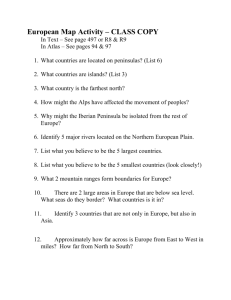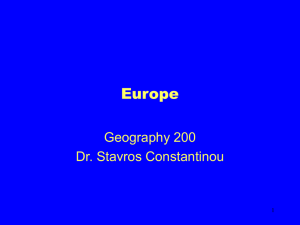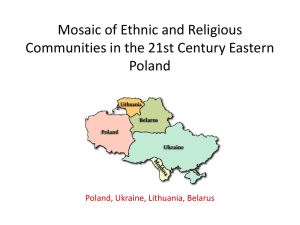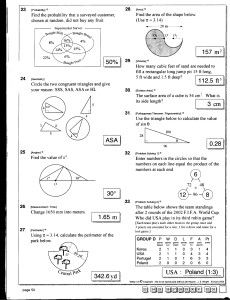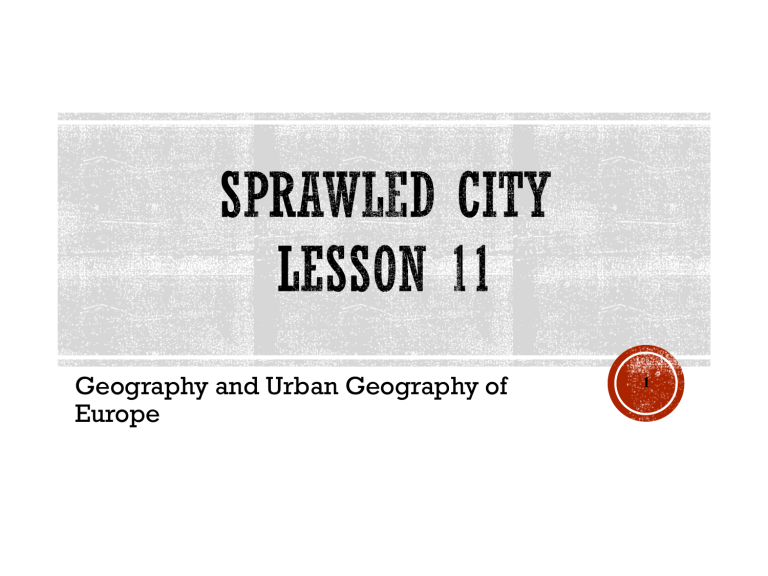
Geography and Urban Geography of Europe 1 • Western extremity of Eurasia • Lingering world influence • High degrees of specialization • Manufacturing dominance • Numerous nation-states • Urbanized population • High standards of living 2 • At the heart of the land hemisphere • Maximum efficiency for contact with the rest of the world • Every part of Europe is close to the sea. • Navigable waterways • Moderate distances 3 • Excluding Russia, Europe occupies only 3.4% of the global surface (2,284,509 sq. miles). • Europe has a high-latitude northerly location. • Much of Europe lies north of the conterminous United States (north of the 49th parallel). • Scotland lies in the same general latitude as Hudson Bay, and Norway has many communities located as far north as the northern mainland of Canada. 4 • Europe has an irregular outline, and is largely formed of peninsulas. • The main European peninsula is surrounded by: • First order peninsulas: Scandinavian, Iberian, Italian and Balkan peninsulas. • Second order peninsulas: Jylland (Jutland), Bretagne (Brittany), Cornwall, Peloponnesus (Peloponnesus) and others. • The complex mingling of land and water has provided much of Europe with many opportunities for maritime activities. 5 Most places in Europe are no more than 640 km (400 miles) from the sea. By contrast, parts of the US, interior are more than 1600 km (1000 miles) from salt water. 6 Europe has 13 landlocked states: Andorra Luxembourg Austria Switzerland Belarus Czech Republic Slovakia Macedonia Moldova Hungary San Marino Liechtenstein Vatican City 7 • Western Uplands (Northwestern Highlands) • • Hard, geologically ancient rock Scandinavia, Iceland, Scotland, Ireland, Brittany, Portugal Spain • North European Plain (Lowland) • • Extensive region, a prominent feature of Europe; includes parts of France, Belgium, The Netherlands, Germany, Denmark, Poland, the Baltic states, Belarus and Russia Rich in natural resources; coal, natural gas, potash, salt, iron ore, largest cultivated region • Central Uplands • • Lower and less rugged than mountain regions, geologically older Important deposits of metals and coal • Alpine Mountains • • • High mountains, rugged plateaus, steeply sloping land The Alps, the Pyrenees, the Apennines, Dinaric Alps, and the Carpathians Highest peak is Mont Blanc –4807 meters (15,771 feet) 8 • Climatic controls • Warm currents (North Atlantic Drift) • Westerly winds • Differential of heating between land and water • Europe’s climate is mild for its latitude • London’s average winter temperature is about the same as Richmond, VA, which is 1500 km (950 miles) farther south. • The British Isles, Scandinavia, the Netherlands, Germany and Poland lie north of the conterminous United States • Most lowlands receive 50 centimeters (20 inches) of precipitation per year: • Average in lowlands is 50-89 centimeters • A few highland areas receive 102 (40 inches) –254(100 inches) centimeters per year 9 • Marine West Coast (Cfb) • Humid subtropical (Cfa) • Mediterranean or Dry Summer Subtropical (Csa) • Humid continental (Dfa) • Subarctic (Dc, Dd) • Tundra (ET) • Undifferentiated Highlands (H) 10 • Coniferous forest – Scandinavia • Regions once forested but now mostly cleared for agricultural and industrial development: • Coniferous forest – Germany and Poland • Mixed deciduous forest – southern England, France, Czech Republic,Slovakia, Hungary, Romania and Bulgaria. • Southern Europe's extensive oak forests have been reduced to maquis (brush) and garigue (low scrub). Macchia in Italy, chaparral in California. Reforestation efforts are underway. 11 Generally acidic (Lime is added balance acidity) to Low fertility (alfisols, inceptisols, histosols, spodosols and entisols) Favorable soils: Loess – central France and Poland Mollisols – Danubian Plain 12 • Rich in a variety of mineral resources • Energy sources – coal and petroleum • Iron ore deposits – Sweden, Czech Republic, Alsace-Lorraine (France), English Midlands • Bauxite – Hungary, Greece • Lead -- Sweden • Zinc --Sweden • Scenery – tourist industry 13 Rivers of Northern Europe Swift in summer, frozen in winter Important for generation of electricity Limited use for navigation Rivers of Central Europe Most important river of Europe is the Rhine. Carries more freight than any other river in the world. Originates in Alpine mountain chains of central Europe and flows through Switzerland, Germany, France and The Netherlands Rivers of Southern Europe Of limited use for navigation because of dry summers and high water flow in winter and spring Danube Is the longest river in Europe, but is handicapped by site situation characteristics: Rapids at middle course “iron gate” make navigation impossible Flows through agricultural areas, rather than industrial Other important rivers: Thames (London); Rhone (Marseilles); Seine (Paris); Schelde (Antwerp); Elbe (Hamburg), Po (Italy). 14 • Europe is the third largest population cluster, after East Asia and Southern Asia. • Extremely high population densities are found in western European countries, especially Belgium, the Netherlands and Luxembourg – Benelux. • Population densities are not as high in Eastern and Southern Europe. • Nordic Europe, with the exception of Denmark, is sparsely populated. 15 Current characteristics of Europe’s population: • Falling share of the world’s population • Fertility is at an all-time low • Fewer young people • Smaller working age population • Boom & bust age-dependent • Immigration partially offsetting losses 16 • Europe is among the most highly urbanized regions of the world. • Europe's proportion of urban population has grown from 54% in 1950 to 73% in 2003. • Western European countries have a higher percentage of population living in cities than Eastern Europe. 17 Belgium – 97% Iceland – 94% United Kingdom – 90% Germany – 86% France --- 74% Bosnia-Herzegovina – 40% Albania – 46% Moldova – 46% 18 The urban system of many European countries follows the law of the primate city. According to the law of the primate city, a country’s leading city is “disproportionately large and exceptionally expressive of national capacity and feeling.” (Mark Jefferson, 1939). Examples: Paris personifies France London personifies the UK Amsterdam personifies the Netherlands Warsaw personifies Poland Athens personifies Greece Vienna personifies Austria Stockholm personifies Sweden 19 The trend in European urbanization is toward U.S. style suburbanization. European city scapes differ from North American cities due to: Long histories Scarce land Strong government control of urban land development The internal spatial structure of the European metropolis consists of the central city and its suburban ring, as in London. 20 • The CBD contains the main concentration of business, government, shopping facilities and wealthiest residences. • Broad residential sectors radiate outward from CBD with considerable class differentiation. • European suburbs are highdensity satellite towns or villages surrounded by open countryside that is heavily utilized for recreational purposes. 21 London Berlin Madrid Rome Kiev Paris Bucharest Budapest Barcelona Hamburg Minsk Warsaw Vienna Milan Munich Prague Sofia Belgrade Naples 7,650,944 3,475,392 3,102,846 2,649,765 2,643,000 2,152,432 2,067,545 1,906,798 1,714,355 1,652,383 1,661,000 1,655,700 1,539,848 1,305,591 1,255,623 1,214,174 1,190,126 1,136,786 1,047,987 0 2,000,000 4,000,000 6,000,000 8,000,000 10,000,000 22 • The cultural geography of Europe is very diverse and complex. • Europe is a cultural mosaic, based on language and religion. 23 • Indo-European Family (Major group, detail in next slide) • Uralic Family • Finnie • Northwest (Finnish, Karelian, Estonian) • Lapp • Ugrian (Hungarian) • Altaic Family – Turkish, in Turkish foothold in Europe • Semitic Family – Maltese, spoken on island of Malta • Basque Family – spoken by the Basques of Southwestern France and Northern Spain 24 • Teutonic (Germanic) – English, German-Dutch (Dutch, Flemish and German) and Scandinavian (Swedish, Norwegian, Danish and Icelandic). Romanic (Latin) – French (French and Walloon), Spanish (Castilian and Catalan), Portuguese (Portuguese and Galician), Italian (Italian and Sardinian), Romansch (Rhaeto-Romanic), Romanian (Romanin and Vlakh). Romania, an outlier of the Roman empire, managed to retain its Romance language. Slavic – Western Slavic (Polish, Czech and Slovak), Eastern Slavic (Russian, Ukrainian,Byelo-Ruthenian), Southern Slavic (Slovene, SerboCroat, Bulgarian) Baltic – Latvian and Lithuanian Illyrian -- Albanese Hellenic -- Greek Celtic – Irish, Gaelic, Welsh, Breton 25 • The predominant religion in Europe is Christianity. • Islam is the predominant religion of Albania, and is the religion of many immigrants to northwestern Europe from the Middle East and North Africa. • Religion as a unifying (centripetal) cultural force has been unable to overcome the disunifying (centrifugal) force of nationalism in Europe. 26 • Eastern Christians number 558,729,000 or 76.6% of a total • European population of 729,406,000. • Roman Catholicism dominates in southern Europe, Poland and eastern Germany. 286,124,000 or 39.2% of total European population. • Orthodoxy is the predominant faith in eastern Europe and Greece. 158,775,000 or 21.8% of Europe’s population. • Protestantism (especially Lutheran churches) is the major religion in northern and northwestern Europe. 85,924,000 or 11.8% of the population. • Anglicanism (Episcopalian) number 25,632,000 or 3.5% of Europe's population. • Non Christians: • Islam: 31,401,000 or 4.3% of the total population • Judaism: 2,530,000 or 0.3% of the total population 27 Agriculture High degree of commercialization Dairy farming and livestock farming Specialized subtropical crops in Mediterranean Europe. Major crops Cereals, with wheat the leading cereal grain Rye – Germany and Poland Corn (maize) – Danube plains of Hungary, Romania and Yugoslavia, the Po river valley of Northern Italy and the southwestern lowland of France. Oats and barley Irrigated rice 28 Fisheries High degree of commercialization North sea countries and Iceland Dogger Bank in the North Sea is a famous fishing ground. Norway is the European leader in quantity of fish caught. Europe depends heavily on food imports. It is self-sufficient in milk, potatoes and rye. It imports wheat, corn, oil cake, soybeans, vegetable fats and oils, chilled and frozen meats, cane sugar, cocoa, coffee and tobacco; fibers (cotton and wool predominantly) and natural rubber. 29 Europe produces a wide range of industrial goods, from the most basic to the most technologically advanced. Globalization has caused major changes in the industrial sector. Some famous European products are: Swiss watches English woolens Scotch whiskeys German porcelain and cameras Bohemian glassware Irish linens French wines, brandies and liqueurs 30 The “Four Motors of Europe” are: 1. Southeastern France’s Rhone-Alpes region (anchored by Lyon). 2. Northern Italy’s Lombardy (anchored by Milan). 3. Northeastern Spain’s Catalonia (anchored by Barcelona). 4. Southern Germany's Baden-Württemburg (anchored by Stuttgart). Other important European industrial regions: Sweden: Switzerland: Poland: Austria: Italy: Venice Spain: Bilbao 31 SPATIAL INTERACTION • Movement across geographic space • Involves contact of people in two or more places for the purposes of exchanging goods or ideas Principles • Complementarity • Transferability • Intervening opportunity 32 Two places, through an exchange of goods, can specifically satisfy each other’s demands. One area has a surplus of an item demanded by a second area. 33 The ease with which a commodity may be transported or the capacity to move a good at a bearable cost Rivers, Mountain Passes, Road networks Advances in transportation technology 34 INTEREVENING OPPORTUNITY The presence of a nearer source of supply or opportunity that acts to diminish the attractiveness of more distant sources and sites Would Austrian beer be cheaper to import into Italy? 35 36


